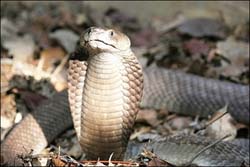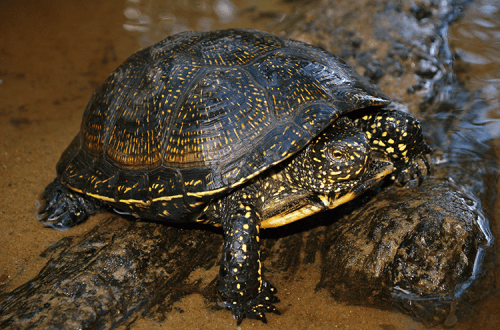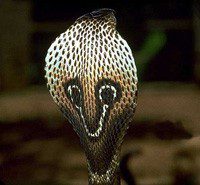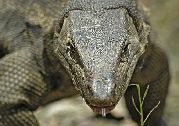
Komodo monitor lizard
The Komodo monitor lizard got its name from the fact that its habitat is the small island of Komodo in Eastern Indonesia, where it was described as a separate species in 1912. These reptiles have hardly changed over the past 2 million years. They take their origin from ancient snakes, having inherited from them a poisonous gland.
Komodo dragons are the largest reptiles on earth. Their dimensions can reach up to 3 meters in length with a weight of 150 kg. Wild monitor lizards are significantly inferior in size to their relatives, which are kept in captivity.
Juveniles of this species are quite brightly colored. From above, they are of a beautiful light chestnut color, which smoothly turns into green-yellow on the nape and neck, and carrot-orange on the shoulders and back. According to such colors, reddish-orange spots and rings are arranged in transverse rows on the body of the animal, which can merge into continuous stripes on the neck and tail. Over time, the color of monitor lizards changes to a uniform dark brown color, on which dirty yellow speckles can sometimes be found.
Contents
Distribution and abundance
The Komodo monitor lizard, in addition to the immediate island of Komodo, also lives on its neighboring islands, such as Rinja and Padar and in the western part of the large island of Flores.
On the island of Komodo there are about 1700 individuals of this species, on the Rink (1300 individuals), about 100 monitor lizards live on Jili Motagan, and about 2000 reptiles en Flores.
Habitat in nature
During the dry season, which falls between July and October, most Komodo dragons adhere to wide dry channels, the banks of which are covered with dense jungle. Deer and wild pigs, which live in large numbers on the islands, trample paths in the thickets of vegetation, along which they move and boil. These animals dig deep holes for themselves, which are located under the roots of trees or large stones. The diameter of such a building can reach up to 5 meters. Young monitor lizards, less than one and a half meters long, use tree hollows located at a considerable height from the ground as shelters.
When the weather is dry, reptiles leave their holes or hollows – shelters early in the morning and do not return to them until evening. All this time they spend moving around the island in search of food, without going out into open areas, so as not to fall under direct sunlight. In the coastal part of the island, their activity persists on warm moonlit nights. The same monitor lizards that live at an altitude of 500 – 700 meters above sea level, where the night temperature drops to + 15 ° C, come from their shelters shortly before sunset, appear from it at sunrise.
Komodo dragons are very fond of water. They actively enter it, sometimes swimming for considerable distances in the sea, visiting numerous small islands, which are located between Komodo, Padar and Rindzhey.
These lizards, being in a calm state, slowly and carefully move on land, raising their body high on outstretched legs, holding a massive tail swinging in time with the movement. During the period of movement, they constantly protrude a long tongue from their mouth, feeling the grass along the way. During the period when the reptile is worried or frightened by something, it crouches down to the ground, but after a while it rises on its front legs to examine the object of interest to it. So the animal, completely motionless, can remain for an hour or more, its dark head towering above the grass from a distance is indistinguishable from the numerous black fragments of lava scattered around.
In the natural distribution area, adult monitor lizards have no natural enemies, so their life expectancy reaches about 50 years. Adults are at the top of the food chain in the islands of their habitat, where there are no predatory mammals. But they become such only at the 10th year of life, and before that period only 1% of hatched monitor lizards survive. Young individuals spend the first two years of their lives in the crowns of trees, where they are inaccessible to adults.
Among these reptiles, intraspecific cannibalism is very common, which is especially pronounced in famine years. Adult lizards feed mainly on carrion, which they themselves receive. They prey on deer, wild boar, buffalo, monkeys and other mammals. Having tracked down and defeated an animal in the bushes. The monitor lizard inflicts a lacerated wound on it, into which numerous bacteria enter from the oral cavity of the reptile, which leads to infection of the blood of the prey and its death. When it dies, monitor lizards from all over the island come running to the smell of carrion, since their olfactory organ is very well developed.
An adult monitor lizard eats large prey always the same. First, he rips open the belly of the animal with his teeth and, plunging his head into it, eats all the insides in about 15 minutes. Then he grabs the edge of the chest with his teeth and with several strong jerks, one after another, tears off large pieces of meat, which, together with the bones, without chewing, and swallows. When swallowing large pieces of meat weighing up to 3 kg. the monitor lizard helps itself with its front paws or, opening its mouth wide, quickly throws its head forward, thus contributing to the fastest passage of food. Sometimes very large pieces of meat or a torn off leg of an ungulate animal get stuck in the throat of a monitor lizard and, trying to free itself, shakes its head vigorously until an uncomfortable piece flies out of its mouth. While eating, the lizard usually stands on four outstretched legs and its belly, slowly filling up, sinks lower and gradually reaches the ground. Having satiated, the animal slowly retreats to the nearest shelter and lies down on the ground to digest food. An adult reptile completely eats a large deer in 3-4 hours.
Young monitor lizards are wary of eating prey at the same time as adults and are content only with pieces flying off to the side. This behavior is caused by the fact that adults often chase and eat young animals. Feeding on large prey, Komodo monitor lizards, especially young ones, occasionally eat smaller animals – insects, lizards, snakes, birds and rodents, as well as fish and marine invertebrates washed ashore.
During the feeding period, the lizards have a very pronounced hierarchy, for the establishment of which fights between males often occur.
Thus, monitor lizards maintain a certain number of animals on the islands, acting also as a destroyer of dead organisms.
Physiology
 Komodo monitor lizards are similar in body structure to other types of lizards, but, of course, they have their own characteristics.
Komodo monitor lizards are similar in body structure to other types of lizards, but, of course, they have their own characteristics.
These monitor lizards have a primitively arranged poisonous gland. The streams of venom are not excreted through special channels in the poisonous teeth, as in snakes, but are located directly under the salivary glands under the lower jaw. The poison oozes from the gums, as does saliva, entering the animal’s mouth at the base of the lower teeth. In the oral cavity, saliva, poison and decaying food mix with each other, thereby forming a terrible cocktail that contains trillions of different bacteria.
After the monitor lizard has eaten, he lies down to digest food in a shady place and falls into a dream, after waking up, he again starts eating. Only with the onset of evening twilight, the lizard falls asleep in a sound sleep so that you can approach it at a very close distance and even touch it. During this period, the animal’s temperature can drop to 20°C, while being 40°C during the day.
The mating season for Komodo dragons is at the end of July. The expectant mother is actively looking for a nest for laying eggs. They are often served by the nests of wild chickens, which build natural incubators – compost heaps from fallen leaves. Having found a pile, the female monitor lizard digs a hole in it, and often several, in order to confuse many wild boars prowling in search of eggs, beforehand she feasts on chicken ones to gain energy. Females lay up to 26 large eggs already in August, some of which can reach 10 cm in length and 6 cm in width, while having a weight of up to 200 g. After that, she no longer moves away from them, waiting for the cubs to hatch . After 8 – 8.5 months (end of March – beginning of April), young lizards emerge from the eggs, reaching a length of 27-30 cm. They immediately leave their mother and climb neighboring trees. To avoid potentially dangerous encounters with adult monitor lizards, the cubs spend the first two years of their lives exclusively in the crowns of trees, where they catch insects and small birds, but also serve as food for snakes and hawks themselves. Young monitor lizards grow very quickly, doubling their size by three months.
When the male is not around during the rut, the female can lay unfertilized eggs, thereby engaging in asexual reproduction – parthenogenesis. In this scenario, all cubs will be male
Unlike adults, young monitor lizards are very shy and at the first danger hide in the crowns of trees.
Content in captivity.
In captivity, Komodo dragons are kept only in some zoos in the world.
Value for man
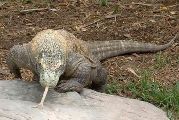 Komodo dragons are among those animal species that pose a serious danger to human life and health.
Komodo dragons are among those animal species that pose a serious danger to human life and health.
Repeatedly there were cases in which these reptiles dug up corpses from the ground and feasted on human flesh. Recently, this is less common, since the dead began to be buried under a heavy slab that the reptile cannot move.
For humans, the bite of monitor lizards is dangerous. Because in the saliva of these dragons, as traditionally believed, there are a lot of bacteria, leading to severe inflammation of the bitten place and even sepsis. Australian scientists, conducting a series of studies with related species of monitor lizards, came to the conclusion that some species of these reptiles are poisonous in themselves. After a person has been bitten by a monitor lizard, it is urgent to consult a doctor, since without proper medical treatment and treatment, this injury in 99% of cases will lead to blood poisoning and death.
Monitor lizards attack people, especially children under 10 years old, which it is not difficult for this giant to cope with. Many cases have been recorded of a Komodo dragon attacking a non-child with fatal consequences for the second. This is mainly due to the fact that the population of the island of Komoda and adjacent to it is growing very rapidly and consists mainly of the poorest fishermen and their families. In famine years, lizards come close to the settlement, driven by the smell of fish and human excrement, and attack people for food. Rangers usually catch such monitor lizards and move them to another part of the island, since killing them is prohibited by law.
Facts
1. When caught, the Komodo monitor lizard can become very excited, turning from a cute passive giant into an angry monster that can beat a person with a tail blow, and cause serious injuries with its jaws.
2. There are known cases of an unprovoked attack of a monitor lizard on a person, and a few years ago, a large individual of the Komodo monitor lizard chased the boys who left the village and killed one of them. On another occasion, the lizard attacked adult men who were carrying a dead deer.
3. When kept in captivity (these cases are very rare), giant reptiles quickly get used to humans and become almost tame. One such representative of the species lived in the London Zoo, he responded to the nickname, took food from the hands of a person and ran on the heels of his keepers.
4. Currently, a national park is organized on the islands of Komodo and Rinja. Any hunting of these lizards is prohibited by law, and catching can only be done for zoos with special permission from the Committee for Nature Conservation under the Government of Indonesia.
5. The Komodo monitor lizard has been included in the Red List of the International Council for the Conservation of Nature and Natural Resources (IUCN) since 1980.



